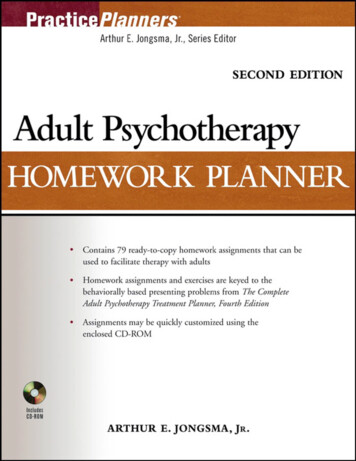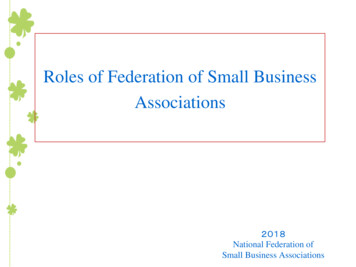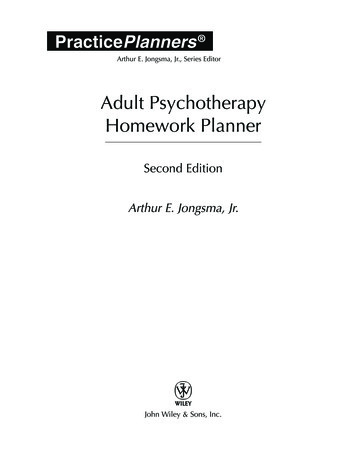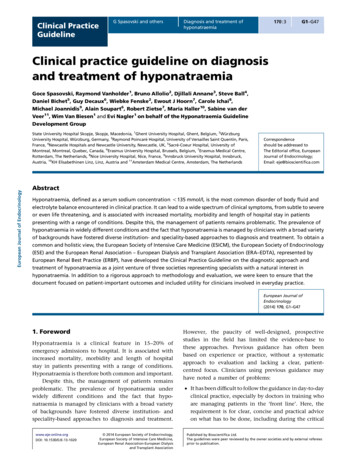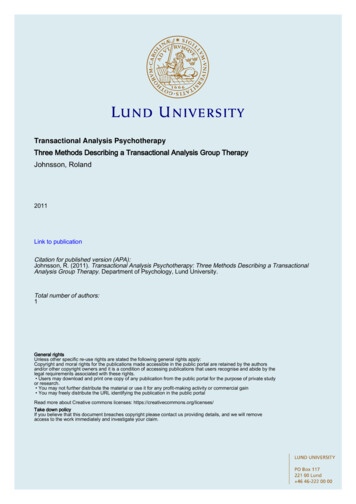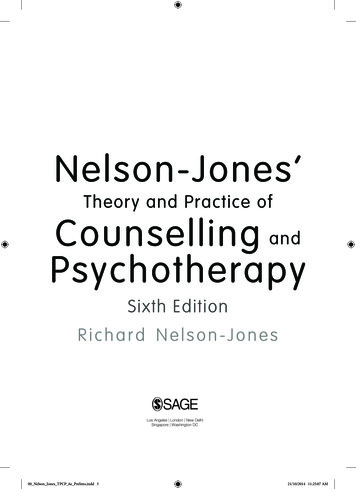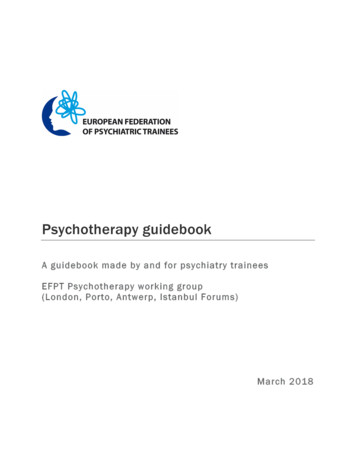
Transcription
Psychotherapy guidebookA guidebook made by and for psychiatry traineesEFPT Psychotherapy working group(London, Porto, Antwerp, Istanbul Forums)March 20181
IndexIntroduction. 3Cognitive Behavioural Therapy (CBT) . 5Rational emotive behavior therapy (REBT) . 10Interpersonal Psychotherapy . 14Mindfulness therapy . 20Client-Centered Psychotherapy. 25Psychoeducation . 28Cognitive Remediation Therapy . 32Psychoanalysis . 35Institutional Psychotherapy. 42Psychodrama . 47Family Therapy . 54Supportive psychotherapy . 602
IntroductionPsychotherapy is an important aspect in psychiatry. When patients ask about different therapyoptions, psychiatrists should know about these, and preferably be able to deliver some therapythemselves. In our recent survey of 574 trainees and young psychiatrists in Europe, 92 %considered psychotherapy important for their professional identity, and 90% wanted topractice psychotherapy after psychiatry training. However, the training possibilities are scarceand only 52 % of trainees were training (or trained) in psychotherapy. (Gargot et al, 2017).Psychotherapy efficacy studies are quite hard to produce as there are still methodologicalproblems to consider, but a lot of studies show a size effect comparable with biologicaltreatments, even for severe illnesses like schizophrenia (Xia, et al, 2011).Some authors state that there are more than one hundred kinds of psychotherapies. Thus, it isdifficult to comprehend and to orientate ourselves in this jungle. The literature argues thaneven if the basic underpinnings and the practical aspects are very different between types ofpsychotherapies, there are important common factors (motivation of the patient, empathy,transference, the therapeutic alliance) that lead to a general efficacy of psychological therapies.That's why, as trainees throughout Europe, we wanted to share with you our different tastes ofdifferent kinds of psychotherapies based on our interest. Even though the diversity is large, wetried to use the same template for every kind of psychotherapy, and to promote books,psychotherapy associations and congresses related to each school. This work doesn't pretendto be exhaustive but would like to open trainees to the richness of this field.As a psychiatrist, one needs to keep an open mind to other disciplines. In the past, discoveriesabout the unconscious inspired psychoanalysis, neuropsychology inspired cognitiveremediation therapy, theatre inspired psychodrama, ancient Buddhism inspired mindfulness.Patients and familly associations always challenged our practices in psychoeducation andInstitutional psychotherapy to became as patient-centred as possible.Maybe in the future, social psychology (eg. cognitive dissonance and engagement theories) willimprove our understanding of general factors and improve the links with Patient centeredpsychotherapy and Motivational lnterviewing. An Emerging field of combinations of drugs withpsychotherapy (for instance exposure and beta-blockers after a trauma) will be interesting tofollow, and neuropsychoanalysis could inspire new psychotherapeutic approaches. Newtechnologies challenge psychotherapy with computer-based cognitive remediation andpsychoeducation. They also offer easier training with massive open online courses like thecognitive behavioural therapy programmes run by the European Psychiatry Association or theBeck Institute. The road of psychotherapy is still open and long.This work is still in progress and any feedback is appreciated. We struggled hard against socialloafing and perfectionism to present you this work that we hope will inspire you! We thank theEFPT board that encouraged and found this project, and Chantelle Wiseman (a native Englishspeaker) who revised the different articles.Thomas Gargot, MD, Psychiatry, PhD Student, on behalf of the psychotherapy working group3
Figure 1 Psychotherapy working group physical meeting in Istanbul, during the EFPT forum 2017adress : http://efpt.eu/wg/psychotherapy-wg/mailing list : efpt-psychotherapy-wg@googlegroups.com4
Cognitive Behavioural Therapy (CBT)Chapter written by Olga Sidorova Psychiatry Trainee from Rīga Stradiņš University– Departmentof Psychiatry and Addiction Medicine – Riga, LatviaCognitive behavioural therapy (CBT) is the most widely used evidence-based psychotherapy forimproving mental health.Brief historic overviewCognitive behavioural therapy is a fusion of the behavioural and cognitive theories of humanbehaviour and psychopathology. Modern CBT development had three “waves”.The first, or behavioural wave was inspired and developed by notable people such as John B.Watson, Joseph Wolpe, Ivan Pavlov, Hans Eysenck, Arnold Lazarus and B. F. Skinner and comesfrom learning theory (Skinner et Pavlov). Learning theory is a concept describing the process ofgaining, keeping and recalling knowledge. Behavioural learning theory assumes that learning isbuilt on responses to environmental stimuli. I. Pavlov introduced a concept of classicalconditioning where behaviour is a reflexive and involuntary response to stimuli. The exposure,which originated from the works of Pavlov and Watson, is a widely used instrument in CBT. It isa process of changing the unwanted, learned response or behaviour to a more desirableresponse. In addition to this, B. F. Skinner later shaped a concept of operant conditioning,which is based on the voluntary behaviour that is modified through the use of positive andnegative reinforcements. The foundation for the second or “cognitive wave” of CBT can betracked to numerous ancient philosophical ideas, notably in Stoicisms. Stoic philosophers,particularly Epictetus, believed that logic could be used to identify and discard false beliefs thatlead to destructive emotions and that individuals are responsible for their own actions, whichthey can examine and control through rigorous self-discipline. These philosophical ideasinspired Alfred Adler, one of the first therapists who implemented cognition into apsychotherapeutic approach. He developed the concept of basic mistakes and showed howthey create unhealthy behavioural and life goals. Albert Ellis, inspired by Adler's work,developed the earliest cognitive-based psychotherapy, known as rational emotive behaviourtherapy (REBT). (Check the REBT chapter in this book p.10)Meanwhile, in the early 1960's Dr Aaron T. Beck (who was a fully trained and practicingpsychoanalyst), in his search of explanations for depression identified distorted, negativecognitions as a primary feature of the disease. He developed a short-term treatment with afocus on reality testing of patients' depressed thinking.Both Aaron T. Beck and Albert Ellis, developed approaches which gained wide popularity amongbehavioural therapists.The third wave is the evaluation and use of emotions with Mindfulness based therapies andacceptance based therapies, like Acceptance and Commitment therapy. (Check the Mindfulnesschapter in this book p. 20)5
DescriptionCBT treatment is based on a cognitive formulation, the beliefs and behavioural strategies thatcharacterise a specific disorder. CBT has certain basic principles for treatment listed here:CBT is based on an ever-evolving formulation of patients' problems and an individualconceptualisation of each patient in cognitive terms.CBT requires a therapeutic alliance.CBT emphasises collaboration and active participation.CBT is goal-oriented and problem-focused.CBT initially emphasises the present.CBT is educational, and aims to teach the patient autonomy, how to be her own therapist andemphasizes relapse prevention.CBT aims to be time-limited.CBT sessions are structured.CBT teaches patients to identify, evaluate, and respond to their dysfunctional thoughts andbeliefs.CBT uses a variety of techniques to change thinking, mood, and behaviour.Main uses (indications)CBT started as a therapy for patients with depression. Lately adapted and developed to diverseset of disorders and problems. CBT can be used with patients with divergent levels of educationand income, various cultural background and ages, from children to seniors.Partial List of Disorders Successfully Treated by Cognitive Behaviour TherapyPsychiatric disordersPsychological problemsMedical problems withpsychological componentsMajor depressiveCouple problemsChronic back paindisorderFamily problemsPainGeneralized anxietyPathological gamblingdisorderPanic disorderComplicated griefTinnitusAgoraphobiaCaregivers distressSocial phobiaAnger and hostilityObsessive-compulsivedisorderSubstance abuseErectile ating disordersInsomniaHealth anxietyObesityBody dysmorphicVulvodynia6
disorderEating disordersSex offendersPersonality disordersHypertensionPTSDBipolar disorder (withmedication)Schizophrenia (withmedication)Adapted from Judith S. Beck Phd Cognitive Behavior Therapy Basics and Beyond, Second EditionEfficacyCBT has been widely tested since 1977, and today more than 1000 research studies (e.g.,Hofmann 2012) have demonstrated the efficacy of CBT for various psychiatric disorders,psychological problems and medical problems with a psychological component.Comment from an expert and or quote from a famouspsychotherapist:"What matters is our attitude toward facts rather than the facts themselves. This also applies tothe facts of our inner life.”Viktor FranklComment from a trainee with experienceCBT is a comprehensive psychotherapy focusing pragmatically on how to help the patient.Many specific tools can be useful in everyday practice: for instance exposure, assertivenesstechniques, role-plays, motivational interviewing, and cognitive restructuring. The functionalanalysis and the vicious circles taken from learning theory helps to conceptualize thefunctioning of the patients, destigmatise their symptoms and help them to understand betterhow to have more distance with their functioning and change it.Thomas GargotBooks, manual, videos, application, published onlinecourses or international association- Research possibilities and CoursesBeck Institute online ine-training/MOOC Understanding Anxiety, Depression and ression-and-cbtThe European Psychiatric Association is preparing its first Massive Open Online course aboutCBT7
Bibliography: Hofmann, S. G., Asnaani, A., Vonk, I. J.,Sawyer, A. T., & Fang, A. (2012). Theefficacy of cognitive behavioral therapy: Areview of meta-analyses. Cognitive therapyand research, 36(5), 427-440.Beck, J.S. (2011). Cognitive BehaviorTherapy, Second Edition: Basics andBeyond. The Guilford Press: New YorkCully, J.A., Teten, A.L. (2008). A Therapist’sGuide to Brief Cognitive BehavioralTherapy. Gully and Teten BehavioralTherapy. Department of Veterans AffairsSouth Central MIRECC: Houston.Riggenbach, J. (2012). The CBT Toolbox: AWorkbook for Clients and Clinicians.Premier Publishing & Media.Manning, J., Ridgeway, N. (2016). CBTWorksheets. Create Space (2016).Carlson, M. (2014). CBT for Chronic Pain andPsychological Well-Being. Wiley-Blackwell:Hoboken, New Jersey.Tolin, D.F. (2016). Doing CBT: AComprehensive Guide to Working withBehaviors, Thoughts, and Emotions. TheGuilford Press: New York. Knaus, W.J. (2014). The CognitiveBehavioral Workbook for Anxiety, SecondEdition: A Step-By-Step Program. NewHarbinger Publications: Oakland, CaliforniaBunge, E.L., Mandil, J., Consoli, A.J., Gomar,M. (2017). CBT Strategies for Anxious andDepressed Children and Adolescents. TheGuilford Press: New York.Wallace, L. (2016). Cognitive BehaviouralTherapy. Independently published.Greenberger, D., Padesky, C.A. (2015). MindOver Mood, Second Edition: Change HowYou Feel by Changing the Way You ThinkThe Guilford Press: New York.Joseph, A. (2017). Cognitive BehaviourTherapy: Your Route out of Perfectionism,Self-Sabotage and Other Everyday Habitswith CBT [Audiobook]. Audible StudiosBill, Y. (2016). Cognitive Behavioral Therapy:CBT Techniques to Manage Your Anxiety,Depression, Compulsive Behavior, PTSD,Negative Thoughts and Phobias[Audiobook]. John LeddyThrive: The Power of Evidence-BasedPsychological Therapies - Richard Layard,David M. Clark -Book, ALLEN LANE HBcollection, 2014Links to SocietiesEurope:European Association for Behavioural and Cognitive Therapieshttp://www.eabct.eu/National CBT associations can be found here http://www.eabct.eu/find-a-therapist/The EABCT organize a yearly congress to present the recent developments of CBT.International:International Association of Cognitive Behavioral Therapyhttp://www.the-iacp.com/Association for Behavioral and Cognitive Therapieshttp://abct.org/Home/International Union of Psychological Sciencehttp://www.iupsys.net/Private Centers and InstitutesAmerican Institute for Cognitive Therapyhttp://www.cognitivetherapynyc.com/8
Albert Ellis Institutehttp://www.rebt.org/Beck Institute for Cognitive Therapy and Research, they organize online tive Behaviour or therapy/Journal of Behavior Therapy and Experimental 9
Rational emotive behavior therapy (REBT)Chapter written by Milos Lazarevic and Vladimir Djuric, psychiatry trainees from Belgrade,SerbiaBrief historic overviewRational emotive behavior therapy (REBT) is an actionoriented psychotherapy that teaches individuals to identify,challenge, and replace their self-defeating beliefs withhealthier ones that promote emotional well-being and goalachievement. REBT was developed in 1955 by Dr. Albert Ellis.Dr. Ellis is considered to be one of the most influentialpsychotherapists in history, and REBT is now one of thecognitive therapies. Ellis' first major publication on RationalTherapy describes the philosophical basis of it as the principlethat a person is rarely affected emotionally by outside things,but rather by ‘his perceptions, attitudes, or internalisedsentences about outside things and events', which hecompares to the writing of the Greek philosopher Epictetus inthe Enchiridion: "Men are disturbed not by things, but by theviews which they take of them." Shakespeare, many centurieslater, rephrased this thought in Hamlet: "There's nothing good or bad but thinking makes it so."DescriptionA fundamental premise of REBT is thathumans do not get emotionally disturbedby unfortunate circumstances, but by howthey construct their views of thesecircumstances through their language,evaluative beliefs, meanings andphilosophies about the world, themselvesand others. In REBT, clients usually learnand begin to apply this premise by learningthe A-B-C-D-E-F model of psychologicaldisturbance and change (Fig.1). The A-B-Cmodel states that it is not an A (adversityor activating event) that cause disturbedFigure 1and dysfunctional emotional andbehavioral Cs, (consequences), but alsowhat people B (irrationally belief) about the A (adversity). A (adversity) can be an externalsituation, or a thought, a feeling or other kind of internal event, and it can refer to an event inthe past, present, or future.The Bs (irrational beliefs) that are most important in the A-B-C model are explicit and implicitphilosophical meanings and assumptions about events, personal desires, and preferences. The10
Bs (beliefs) that are most significant are highly evaluative and consist of interrelated andintegrated cognitive, emotional and behavioral aspects and dimensions. According to REBT, if aperson's evaluative B, belief about the A, activating event is rigid, absolutistic, fictional anddysfunctional, the C (the emotional and behavioral consequence), is likely to be self-defeatingand destructive. Alternatively, if a person's belief is preferential, flexible and constructive, the C(the emotional and behavioral consequence) is likely to be self-helping and constructive.Through REBT, by understanding the role of their mediating, evaluative and philosophicallybased illogical, unrealistic and self-defeating meanings, interpretations and assumptions indisturbance, individuals can learn to identify them, then go to D, disputing and questioning theevidence for them. At E, effective new philosophy, they can recognize and reinforce the notionno evidence exists for any psychopathological must, ought or should and distinguish them fromhealthy constructs, and subscribe to more constructive and self-helping philosophies. This newreasonable perspective leads to F, new feelings and behaviors appropriate to the A they areaddressing in the exercise.Main uses (indications)AddictionsAnger and Related DisordersAnxiety DisordersBipolar and Related DisordersChallenges Related to Daily Living- Social Skills and Assertiveness Deficits- Career & Lifestyle Changes- Procrastination- Relationship DifficultiesDepressive DisordersDisruptive, Impulse-Control and ConductDisordersObsessive-Compulsive and RelatedDisordersPersonality DisordersTrauma- and Stressor-Related DisordersEfficacyREBT and CBT in general have a substantial and strong research base to verify and support boththeir psychotherapeutic efficiency and their theoretical underpinnings. A great quantity ofscientific empirical studies has proven REBT to be an effective and efficient treatment for manykinds of psychopathology, conditions and problems. A vast amount of outcome andexperimental studies support the effectiveness of REBT and CBT. Recently, REBT randomizedclinical trials have offered a positive view on the efficacy of REBT.In general REBT is arguably one of the most investigated theories in the field of psychotherapy,and a large amount of clinical experience and a substantial body of modern psychologicalresearch have validated and substantiated many of REBTs theoretical assumptions onpersonality and psychotherapyComment from an expert and or quote from a famouspsychotherapist (founder)“There are three musts that hold us back: I must do well. You must treat me well. And theworld must be easy.” Albert Ellis11
“The best years of your life are the ones in which you decide your problems are your own. Youdo not blame them on your mother, the ecology, or the president. You realize that you controlyour own destiny.”Albert EllisComment from a trainee with some kind of experience(duration of the training, personnal thoughts)“My favorite metaphor, which I have learned in my REBT training, is the one comparing life andthe chess game. No matter how many bad moves you have played and what important figuresyou have lost, you should concentrate on choosing your next move rationally. In REBT our mainfocus is to teach our clients new way of thinking, so they could play their life chess game in avictorious way in future. I also like the great emphasis on unconditional self acceptance,because I think that it is the most important keeper of mental health. It helped me through my4 year REBT training and life challenges (activating events)”Vladimir Djuric (Serbia, REBT psychotherapist under supervision)Books, manual, videos, published online courses orinternational association Ellis, A. (1994) Reason and Emotionin Psychotherapy: ComprehensiveMethod of Treating HumanDisturbances : Revised and Updated.New York, NY: Citadel PressEllis, A. (2004) Rational EmotiveBehavior Therapy: It Works for Me—It Can Work for You. Amherst, NY:Prometheus Books.McMahon, J., &d Vernon, A. (2010)Albert Ellis: Evolution of aRevolution: Selections from theWritings of Albert Ellis, Ph.D. FortLee, NJ: Barricade Books.Ellis, A. (2007) All Out! AnAutobiography. Amherst, NY:Prometheus Books.Velten, E. (2010) Under theInfluence: Reflections of Albert Ellis in the Work of Others. Tucson, AZ:See Sharp PressEllis, Albert (1962) Reason andEmotion in Psychotherapy. p. 54Ellis, Albert (2001). OvercomingDestructive Beliefs, Feelings, andBehaviors: New Directions forRational Emotive Behavior Therapy.Prometheus Books.Dryden W., & Neenan M. (2003).Essential Rational EmotiveBehaviour Therapy. Wiley.Ellis, Albert. (1994). Reason andEmotion In Psychotherapy, Revisedand Updated. Secaucus, NJ: CarolPublishing GroupEllis, A. (2001). Feeling better,getting better, staying better.Impact PublishersFor more detailed bibliography and information the official Albert Ellis Institute sitehttp://www.albertellis.org/12
Research possibilitiesAs evidence based psychotherapeutic method REBT offers many research possibilities whichcould be reached on research tab on the official site of Albert Ellis InstituteFor each country: - Links to SocietiesFranceInstitut Francais de Therapie CognitiveDidier Pleux, Dr. of Psych.2 Passage Chanoine Cousin14000 Caen, France(Tel)(33) tut fuer Kognitives Management, StuttgartMilenko and Simona VlajkovEberhardstr. 4A, 70173 Stuttgart, Germany(Tel.) (49) c@yahoo.dekmteam.deDeutsches Institut fuer Rational-Emotive& Kognitive Verhaltenstherapie (DIREKT) e.V.Dieter Schwartz, Dipl.Psych.Burkhard Hoellen, Dipl.Psych.Muellersweg 14D-97249 EisingenWuerzburg, Germany(Tel.) (49) ic Institute for Rational Emotive & Cognitive BehaviorPsychotherapyChrysoula Kostogiannis, Ph.D.Aristeidou 3Marousi, Athens TK 15122Greece(Tel.) li Center for REBTRuth Malkinson, Ph.D.27 Gluskin St.Rehovot 76470, Israel(Tel.) (972) 8-9463165malkins@agri.huji.ac.ilSusana Kigel, M.A.6 Hashirion St.Nes Ziona 76041, Israel(Tel.) stituut voor Rationeel-Emotieve TrainingDrs. Wouter BackxLange Herenstraat 41 Haarlem, Netherlands(Tel.) (31) maniaRomanian Center for Cognitive & REBTDaniel David, Professor, Ph.D. – DirectorRepublicii St., No. 37, 400015Cluj-Napoca, Romania(Tel/Fax) 40 264 biaREBT CenterZorica Maric, Ph.D.Tatjana Vukosavljevic Gvozden, Ph.D.Cika Ljubina 15/511102 BelgradeSerbia(Tel.) 011 38111 3691303zormaric@eunet.rsSpainINSTITUT RETFrancesc Sorribes, DirectorCalle Aragon 224, 4-208011, BarcelonaSpain(Tel.) 34 omTurkeyRasyonel Emotif Bilissel Davranissal Araştırma DanismanlikMerkezi Ltd.(Rational Emotive Cognitive Behavioral Research CouncelingCenter)(RE&CB Research and Counseling Center)Murat Artiran, MAAbbasaga Mh. Yıldız Cd.Nesteren Apt. 61/4 BesiktasTurkey(Tel.) (90 212) 327 02 33(90 212 327 0 AEE)(Fax) (90 212) 327 02 ikoloji.comUnited KingdomThe Centre for REBT University of BirminghamJason Jones, Peter Trower and Richard BennettEdgbastonBirminghamB15 2TTUnited Kingdom(Tel.) 44 (0)121 414 nett@bham.ac.ukrebt.bham.ac.uk13
Interpersonal PsychotherapyChapter written by João Borges Ferreira, Psychiatry Trainee from Psychiatric and Mental HealthDepartment – Baixo Vouga Medical Center – Aveiro, Portugal.Reviewed by Benjamin Lavigne, MD, Psychiatrist and Psychotherapist in Les Toises, Lausanne, Suisse, andIPT Supervisor in Centre de Recherches et d’Etudes Appliquees à la Thérapie InterPersonnelle (CREATIP),France.Brief historic overviewWhat became interpersonal psychotherapy (IPT) was developed and tested in New England in astudy designed in 1969, when the late Gerald L. Klerman, M.D., Myrna M. Weissman, Ph.D. andtheir colleagues added a psychotherapy condition to an 8-month randomised controlled trialfor patients with major depressive disorder. IPT thus became part of the first clinical efficacystudy of pharmacotherapy and psychotherapy for depression (Klerman, DiMascio, Weissman,Prusoff, & Paykel, 1974). The study yielded a manualised, time-limited psychotherapy, initiallycalled ‘high contact’ and then renamed IPT. IPT was based on the principles of a medical model,defining major depression as a diagnosable and treatable psychiatric illness, and on empiricallyderived interpersonal factors related to depression (Klerman, Weissman, Rounsaville, &Chevron, 1984).As scientific evidence accumulated showing that IPT is a treatment that works for severaldisorders, investigators pursued opportunities to share their ideas about IPT research andtraining with each other. The earliest gatherings of IPT professionals were held in conjunctionwith meetings of the American Psychiatric Association in the late 1990’s, organised by JohnMarkowitz, M.D. In 2002, the International Society for Interpersonal Psychotherapy (ISIPT) wasformally incorporated in Australia. The organisation moved to the United States in2010. ISIPT’s first formal elections were held in 2015. Holly Swartz, M.D. was ISIPT’s firstelected President, serving for a two-year term (2015-17), in accordance with newly ratifiedbylaws. In 2016, ISIPT was reincorporated in Brentwood, Tennessee.Since 2002, the activities of ISIPT have been directed toward furthering IPT research andtraining, and supporting the professional development of IPT practitioners.DescriptionIPT is a time-limited, diagnosis-targeted, well-studied, manualised treatment for majordepression and other psychiatric disorders. By improving their lives and providing symptomaticrelief, therapists help patients to solve an interpersonal crisis. IPT helps patients to improveinterpersonal situations by helping them to understand their emotions as social signals whichleads them to mobilise social support. Its success in a series of research studies has led to itsinclusion in numerous national and international treatment guidelines.Diagnosis-targeted: IPT has demonstrated efficacy as an acute and as a maintenancetreatment for major depression, and for patients from adolescence to old age; with social14
rhythm regulation, as an adjunct to medication for bipolar disorder; for bulimia and bingeeating disorders; and, more recently in the field of research, for posttraumatic stress disorder(PTSD) and anxiety disorders.Theoretical Rationale: IPT’s development was influenced by the interpersonal school ofpsychology and its leaders such as Harry Stack Sullivan and Adolf Meyer. Sullivan argued thatpsychopathology arose in the context of conflict between an individual and his primary socialunit. Meyer extended Sullivan’s argument, drawing the distinction between the psychoanalyticfocus on intra-psychic conflict as a primary locus of psychopathology versus an emphasis oninterpersonal conflicts as the genesis of psychopathology in the interpersonal school. IPT alsodraws on the work of Frieda Fromm-Reichmann who emphasised the social roots of depression,Jerome Frank who articulated a sociocultural definition of psychotherapy, and attachmenttheorists such as John Bowlby.Medical Model: IPT uses the medical model as a conceptual framework for patients’ moodsymptoms. In the context of initiating IPT, the therapist conducts a psychiatric history anddiagnoses a current episode of major depression according to DSM 5 criteria. The IPT therapistlikens the depressive episode to other medical illnesses (“no different than asthma or diabetesor pneumonia”) and further explains that the patient has an inherited, biologic vulnerability todepression. Using the medical model as a framework, the IPT therapist stresses that it is not thepatient’s “fault” for developing depression–any more than it is someone’s “fault” fordeveloping pneumonia. Using a stress-diathesis model to explain the interaction betweenbiological vulnerability and stressful life events, IPT further posits (and makes explicit topatients) that although individuals are not to blame for their illness, they are in an excellentposition to help themselves recover from depression by attending to the interpersonal factorsthat may serve as triggers for the underlying biologic illness.Key IPT StrategiesTime Limited: IPT was originally conceptualised to be delivered as 12-16 weekly, 45-50minute, individual sessions. IPT has been tested in an even shorter, 8-session, brief format.Interpersonal Inventory: The inventory is an extended psychosocial assessment. Thetherapist carefully reviews the important people in the patient’s life and the quality of thoserelationships. The therapist seeks to understand the sources of social support, nature ofconfiding relationships, romantic attachments, interpersonal communication style, andrelationship difficulties that may be
review of meta-analyses. Cognitive therapy and research, 36(5), 427-440. Beck, J.S. (2011). Cognitive Behavior Therapy, Second Edition: Basics and Beyond. The Guilford Press: New York Cully, J.A., Teten, A.L. (2008). A Therapist’s Guide to Brief Cognitive Behavioral Therapy. Gully and Teten
